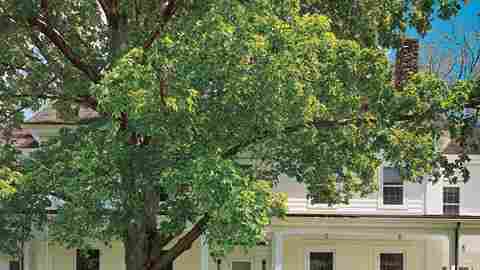Country Clarity
View Slideshow

Poetry is the maximum abbreviation with the minimum loss of meaning—a principle that funnels the chaste, utopian passions of Shaker craftsmanship as well as the more cerebral ideals of modernism. Those are the predominant influences in an upstate New York retreat belonging to a young couple who collaborated with the Manhattan design firm of Shelton, Mindel Associates and the Washington, Connecticut-based architect Peter Talbot to achieve a remarkably lucid synthesis of the historic with the contemporary.
"We always begin by asking our clients not what they want in a house but what they can't live without," says Lee F. Mindel. "Then we focus, clarify and distill those needs to their essential form. Restraint is the real millennial luxury, and while this project was technically and aesthetically ambitious, the scale is tight, the detail lean—and that, I think, is what makes the architecture so expressive. It's the antithesis of a pretentious showplace pumped up with amenities."
The project began more than a decade ago as the fairly straightforward expansion of an 1841 Greek Revival farmhouse and evolved into an intricate game of "musical houses," as Mindel puts it. The original dwelling was a small structure of one and a half stories, with four principal rooms, that had belonged to a well-known artist. The couple rented it for a year, becoming familiar with the movement of the light, the thinning and thickening of the foliage, and with their own requirements for private and communal spaces. When the property came up for sale, says the wife, "we jumped at the chance to own a piece of heaven."
At first they simply envisaged finishing the second story and expanding the ground floor. But when the initial renovation plans were complete, "the addition had so enveloped the shell," says Talbot, "that one lost a sense of its historical significance. So we moved the farmhouse to a different location on the site, where it became a very spacious guest annex, and began work—from the ground up—on a new main residence."
"I never wanted a modern house," explains the wife, "though I also couldn't live in a fussy period reproduction. The whole purpose of building a country place in a secluded valley is to enjoy a rapport with the landscape and to escape from the stresses of city life. Simplicity was our mandate." She and her husband asked their design team for an interpretive rather than a literal translation of the Greek Revival style, which would respect its proportions and its character—wide floorboards, pocket doors, multipaned windows of restoration glass—while integrating the latest technology with a rarefied collection of twentieth-century art and furnishings.
Posture is as important to an edifice as it is to a body, and the spine of the house is a center hall with a vaulted ceiling and walls paneled in unvarnished white oak. It was inspired by a Shaker stairwell at Pleasant Hill in Kentucky and informed by the modernist impulse to treat wood grain as an object for contemplation rather than as a decorative backdrop. The wife herself helped choose the oak tree and match the flitches, "standing," she says, "behind the craftsman" while he wielded the saw.
The limbs of the house—its twelve rooms—are symmetrically aligned, and paneling recurs as theme and variation in all of them: as vertical wainscoting in the kitchen's dining alcove and the master bath; as horizontal wainscoting on the ceilings of the public spaces; and to frame the fireplace in the family room. A Piero Fornasetti screen has a trompe l'oeil oak-paneled door, and in the office, the same motif translates to an unusual Renaissance Revival-style armoire.
When the artist sold his house to the couple, he also left them most of its contents, which are now in the guest annex—a more casual space. "We started decorating from scratch," recalls the wife, "though I knew the mood I wanted, which wasn't chintz and throw pillows." Like Shelton and Mindel, she prefers "a serene, monochrome palette to color, and texture to pattern," she says.
"We have two young children, who were born here, and two dogs, so comfort and practicality were essential. Most of the upholstered seating has slipcovers that change with the seasons, and Lee designed a rug for the family room with a latex nap that's completely washable."
Shelton and Mindel were, while working on the project, also designing a German ocean liner and spending a good deal of time abroad. They shopped for the house in Copenhagen, Stockholm, London, Paris and Amsterdam as well as in New York, sending back photographs of the furnishings they hoped the couple would acquire. "They're young, but their taste is disciplined—even visionary," says Mindel, "and they embraced our curatorial approach." The décor, adds Peter Shelton, "rejects excess and transcends labels." It incorporates pieces by many of the greatest twentieth-century masters, in addition to some choice antiques: 1930 leather chairs by Fritz Henningsen; desks by Jacques-Emile Ruhlmann, Pierre Chareau and Jean Prouvé; a Jacques Adnet dining table and chairs; a Jules Leleu sofa and armchairs; low tables by Gio Ponti and George Nakashima; an Arts and Crafts partners desk; a rare Boiceau carpet. The leather armchairs in the living room were inspired by originals in a house by McKim, Mead White, though their baronial proportions were reduced to a more appropriate scale.
"But you haven't done your job if an interior looks precious or shopped,' " notes Lee Mindel. "It's the philosophy behind these furnishings, not their pedigree, that gives them their distinction. They've been used in surprising and intimate ways. And all these modern masters have such a strong point of view that their pieces converse with one another." What they speak is poetry.